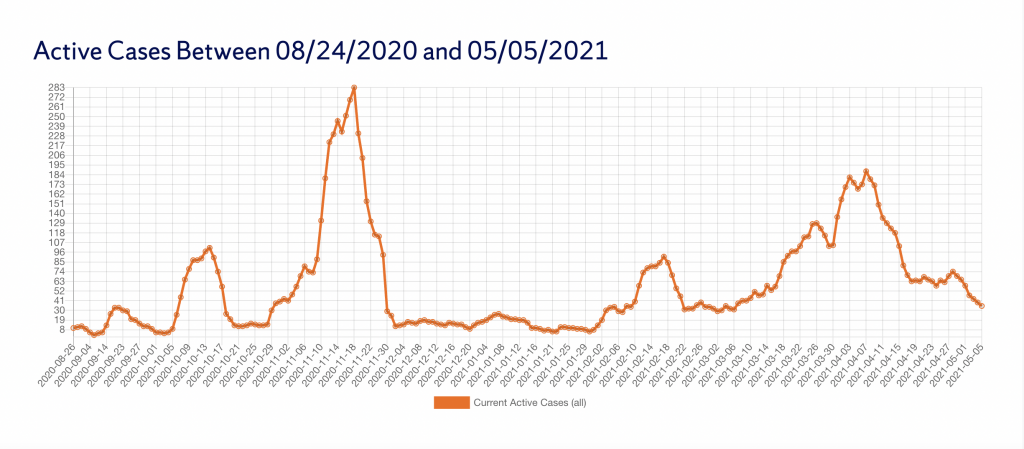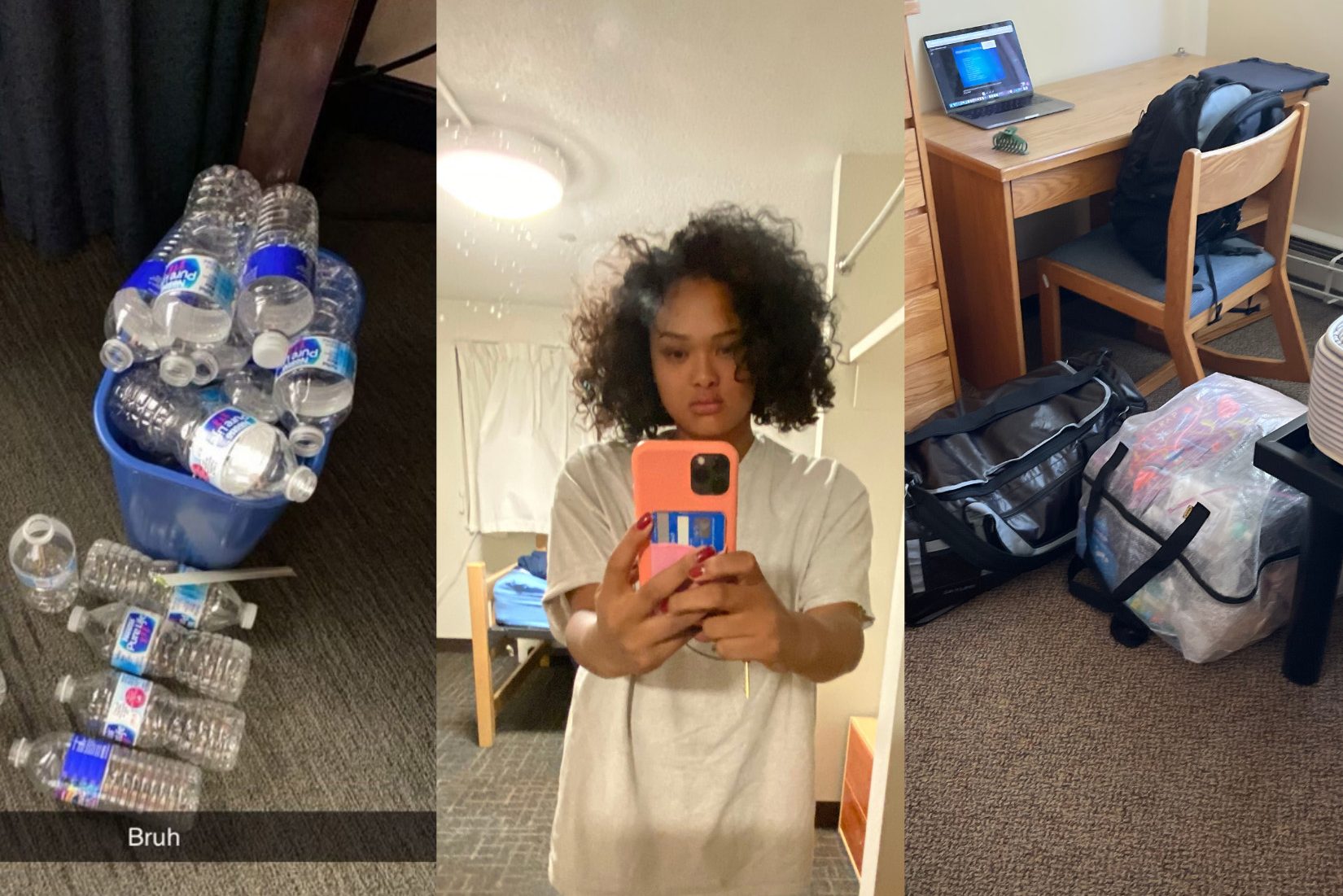What really happened in quarantine and isolation
COVID-19 quarantine and isolation at SU
When Lindsey Singer returned to Syracuse University for her sophomore year in 2020, she had no idea that nearly one month of her first semester back would be in the confinements of a singular room. In early October, Singer had dinner with a friend during which they sat outside for about an hour in accordance with the university’s rules.
Later that week, her friend tested positive for COVID-19, sending Singer into a 14-day quarantine at the Sheraton Hotel & Conference Center. She had limited time to get her things together for the two-week stay before a man in a hazmat suit picked her up in a medical transport van. After two weeks of pacing around the room, calling her friends on the hotel phone, and little to no fresh air, Singer was sent back to her dorm, never having contracted the virus.
Only four days later, Singer was contact traced, again. This began another 14-day isolation period, resulting in nearly one month of solitude for Singer. “Going back in after just being out for a few days was just not sustainable, especially so close to Thanksgiving when no one was going to come back,” Singer said.
Because of the hardships of isolation, and the horror stories passed around amongst students, such as inedible food, forgetting to be fed, and not being able to go outside or see anyone, some students did their best to avoid being sent to quarantine in the first place.
For some, this meant not answering the calls from the contact tracing team at SU. Students tried to be generous when contact tracing because no one wanted to go into isolation if they didn’t have to.
“It was just a jerk move to contact trace someone, you’re just bringing people into the fire,” SU senior Felix Baur said. “No one wanted to be that guy.”
Back in April 2020, SU announced students would be welcomed back to campus for the fall 2020 semester in a hybrid learning method, according to an email to the SU community from Chancellor Kent Syverud.
This return to campus would completely change the college experience for SU students. The academic year would be accelerated, meaning students would not come back to campus after the Thanksgiving break, and there would be a change to the instruction schedule. “This schedule will likely necessitate some additional Friday classes and some classes being held on weekends,” according to an email from Syverud in May 2020.
Most notably, the initial fall reopening plan noted that the University would use the school-owned Sheraton Hotel to quarantine contact-traced students. Students who tested positive for the virus would isolate in South Campus’ Skyhall dormitory, according to Annie Dievendorf, one of SU’s isolation managers at the time.
These two facilities had different rules that changed week by week throughout the pandemic, she said. “Sheraton kids were not allowed to go outside at all. They weren’t ever allowed to leave their rooms,” Dievendorf said. “On South [Campus], sometimes they were allowed to go outside, sometimes had to sign up, and eventually not allowed to go outside at all.”
The facilities also had different rules regarding sharing spaces and seeing others.“Under isolation, students can live within a common space or ‘family unit’ and share facilities with others who have contracted the virus,” said Vice Chancellor for Strategic Initiatives and Innovation Michael Haynie at a virtual forum in July 2020. “Students will only go into quarantine — in which they reside in a single room with a non-shared bathroom — if they have been exposed to the coronavirus.”
The hotel only contains 235 rooms, according to Syracuse.com. By November 18, there were 283 active cases on the SU campus, the highest number of recorded cases for the 2020-2021 school year, according to the SU COVID-19 Dashboard. Due to the requirement of close contacts having to quarantine for 14 days, nearly 600 students were in quarantine at this time, according to the dashboard.

Sophie Walter, a senior art photography major, found herself in quarantine multiple times during her sophomore year. Walter was sent to quarantine at the Sheraton just a few weeks before Thanksgiving break in November 2020 after her roommate tested positive. The Sheraton could not house everyone. . “They didn’t even know we were coming, so they didn’t have rooms set up for us,” Walter said.
According to Walter, the experience was frustrating and uncomfortable, especially being there for two weeks straight without ever testing positive for the virus. Due to the quarantine regulations, students were unable to go outside, or even leave their room, claimed Walter.
“I was going to classes on Zoom, but I couldn’t work out, I couldn’t go on a walk, I couldn’t hang out with friends,” Walter said. “I couldn’t do anything normal.”
At the Sheraton, there was little room for accommodations. Each day, students were given a meal selection sheet to choose their three meals for the following day. But there weren’t many options and there was no way to personalize anything, such as meal times. Breakfast was served early in the morning, at about 8 or 9 a.m.
“I am not a morning person at all,” Walter said. “So I would wake up at 10 and my food would be cold. There were so many people in quarantine that they couldn’t schedule food for each kid.”
When it comes to remembering their days in quarantine, most students recount the quality of food first. Singer described the food at the Sheraton as “disgusting,” claiming that it was often cold and inedible. The hotel refused to provide students with microwaves, so they were unable to heat up anything, even their leftovers from the countless meals they ordered, according to Singer.
“I heated up the water in the bathtub so that I could make soup in it,” Singer said. “I had to spend a lot of money just so I could eat real food.”
While most students mention the unpleasant food and loneliness, some still found the experience relaxing. Deena Netz, who was in isolation twice, both at the Sheraton and on South Campus, says that being in quarantine was a much-needed break. Netz went into quarantine near the end of the Spring 2021 semester, when the quarantine time was only seven days. For her, this experience was better than South Campus. “It was a valid excuse to not really do much,” Netz said. “It was isolating, but I was in a hotel, so it was comfortable.”
Unfortunately, not all students were placed in a hotel room with a clean bathroom and two double beds. Other students, like Netz, were relocated to a dorm room on South Campus after contracting the virus. Netz describes her isolation room as jail-like, with four bare white walls, a twin bed, and a desk. All they gave her were bed sheets, a comforter and a case of Gatorade.
The atmosphere of the South Campus dorm was chilling and terrifying, according to Netz. The hallways were silent as students occupied their time with sleep and iPhone games, while men in hazmat suits came through every day to collect trash and make sure everyone stayed in their rooms. “It felt apocalyptic,” Netz said.
For the majority of her stay, Netz was too sick to do anything. Most of her days were spent sleeping, doing homework if she felt up to it, finding new music to listen to, and playing the game Among Us with others also in quarantine. Toward the end of her quarantine, she was able to spend time with the other students on South Campus. “I made friends on South [Campus],” Netz said. “We shared this weird, hard experience together, and we didn’t want to be alone during it.”

Syracuse senior Kira O’Donnell, agrees that isolation was extremely scary and frustrating. It was April 2021 and O’Donnell said she woke up one morning and instantly knew she had the virus after almost passing out when standing up.
After testing positive, O’Donnell claims she had little time to get her things together before being moved to South. She was allowed 30 minutes to go back into her dorm to pack up the necessities: clothing for two weeks, medications, toiletries, and a shower caddy for the communal bathroom. “I was really rushed,” O’Donnell said. “They had the medical transport van waiting outside my dorm to take me to South Campus.”
For O’Donnell, the lack of empathy and care was the most frustrating part of her experience while she was on South Campus. She recalls not receiving any medical attention during her stay.
“I remember my family being so disappointed in how I was being taken care of because no one even checked in on me or offered to give me medicine,” O’Donnell said. “That combined with the awful food and awful care. I lost 10 pounds while I was there. No one checked on my health once.”
Netz, who also endured the virus on South Campus, agreed that medical care was scarce. She suffered from severe COVID-19 symptoms, including chest pain and shortness of breath, as well as feelings of isolation and fear.
“It was scary, being that sick, and not having anyone,” Netz said. “I was scared something was going to happen to me and no one would know.”
Unlike South Campus, which had “event staff” and DPS outside at all times, the Sheraton had little security to make sure no one came in or out, said Netz. Although there was a lot of fear installed in students on the consequences of leaving quarantine, Baur explains that it wasn’t hard to escape, especially if you knew the times Sheraton staff members came to the designated quarantine floors. “It was as easy as walking down the hall, getting on the elevator, going through the lobby, and walking outside,” Baur said. “I was there for a few days, so I knew the times that people came by to drop off the meals and pick up trash.”
Although students were directed not to leave their rooms, some students, like Baur, would sneak down the hall, or even to different floors, to hang out with roommates or friends who were also in quarantine. “My friend had a handle of whiskey,” Baur said. “It was just us, but we watched a movie and hung out.”
Jack H., who asked to remain anonymous to protect future employment opportunities, said it was hard for students to sneak prohibited items into the hotel because of the routine checks and confiscation procedures conducted by Sheraton staff. But he also notes that the Sheraton didn’t check students’ bags upon arrival to isolation from medical transport.
“I just brought some edibles in my bag,” Jack H. said. “My friend had brought some bud, so we made a little homemade gravity bong with a water bottle.”
In addition to fleeing the Sheraton, students often tried to sneak in prohibited items, like alcohol, marijuana, and vapes, said Baur. This was a harder process than sneaking out because the hotel searched any deliveries before bringing them up to students, according to Baur.
“People were getting really creative. They would carve out the inside of books and put vapes or shooters inside of it,” Baur recalls. “The Sheraton must have confiscated so many things.”






